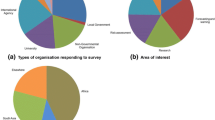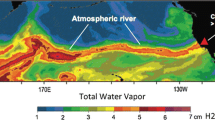Abstract
Natural hazard forecasting products and associated decision support systems provide emergency managers with key information in real-time situations for making life-critical decisions on evacuation orders, deployment of response resources and public information campaigns. A stakeholder engagement strategy was used to investigate potential improvements to storm tide forecasting and decision support systems during tropical cyclone events for the case study site of Queensland, Australia. The requirements of the end-users of the system were identified through a comprehensive survey of local government disaster management staff. The survey assessed their use of the current system, soliciting suggestions for improvements and identifying ‘lessons learnt’ from recent extreme events. Analysis of the survey responses highlights issues with and opportunities for improvement to storm tide forecasting products, including improving spatial resolution and visualisation of warning information and improving the complexity of communication of uncertainty. In particular, the key dilemma between forecast uncertainty and the long timelines required for effective evacuation was highlighted. The survey responses and analysis present a unique insight into stakeholder requirements and will enable user-driven development of a future warning system rather than a forecast-driven product. Broader recommendations for improvement to the storm tide emergency management process derived from the survey include continuous improvement in the accuracy of tropical cyclone forecasting and improving the capacity of both disaster managers and the community to reduce response times to storm tide threat through education and long-term planning decisions.




Similar content being viewed by others
References
Burnside R, Miller DS, Rivera JD (2007) The impact of information and risk perception on the hurricane evacuation decision-making of greater New Orleans residents. Sociol Spectr 27(6):727–740
Blake ES, Kimberlain TB, Berg RJ, Cangialosi, JP, Beven II JL (2013) Hurricane Sandy: October 22–29, 2012 (Tropical Cyclone Report). National Hurricane Center (February 12, 2013). United States National Oceanic and Atmospheric Administration’s National Weather Service
DeMaria M, Knaff JA, Brennan MJ, Brown D, Knabb RD, DeMaria RT, Winters KA (2013) Improvements to the operational tropical cyclone wind speed probability model. Weather Forecast 28(3):586–602
Demerritt D, Nobert S, Cloke H, Pappenberger F (2010) Challenges in communicating and using ensembles in operational flood forecasting. Meteorol Appl 17:209–222
Glade T, Nadim F (2013) Early warning systems for natural hazards and risks. Nat Hazards 70(3):1669–1671
Gladwin H, Lazo J, Morrow B, Peacock W, Willoughby H (2007) Social science research needs for the hurricane forecast and warning system. Nat Hazards Rev 8(3):87–95
Glahn B, Taylor A, Kurkowski N, Shaffer WA (2009) The role of the SLOSH model in National Weather Service storm surge forecasting. Natl Weather Dig 33(1):3–14
Handmer J (2000) Are flood warnings futile? Risk communication in emergencies. Australas J Disaster Trauma Stud 2:1–14
Hanslow D, Nielsen P (1993) Shoreline set-up on natural beaches. J Coast Res Special issue(15):1–10
Harper B, Hardy T, Mason L, Bode L, Young I, Nielsen, P (2001) Queensland climate change and community vulnerability to tropical cyclones: ocean hazards assessment. Stage 1 report. Department of Natural Resources and Mines, Queensland, Brisbane Australia
Harper B, Hardy T, Mason L, Fryar R (2009) Developments in storm tide modelling and risk assessment in the Australian region. Nat Hazards 51:225–238
Heil B, Petzold I, Romang H, Hess J (2010) The common information platform for natural hazards in Switzerland. Nat Hazards 70(3):1673–1687
Joslyn S, Pak K, Jones D, Pyles J, Hunt E (2006) The effect of probabilistic information on threshold forecasts. Weather Forecast 22:804–812
Kang JE, Lindell MK, Prater CS (2007) Hurricane evacuation expectations and actual behavior in Hurricane Lili. J Appl Soc Psychol 37(4):887–903. doi:10.1111/j.1559-1816.2007.00191.x
Keys C, Elliot J, Handmer J, Salter J (1995) Flood warning: an Australian guide. Aust J Emerg Manag 10(2):31–33
Likert R (1932) A technique for the measurement of attitudes. Arch Psychol 22(140):1–55
Lin II, Goni GJ, Knaff JA, Forbes C, Ali MM (2013) Ocean heat content for tropical cyclone intensity forecasting and its impact on storm surge. Nat Hazards 66(3):1481–1500
Lindell MK, Kang JE, Prater CS (2011) The logistics of household hurricane evacuation. Nat Hazards 58(3):1093–1109
McCarthy S, Tunstall S, Parker D, Faulkner H, Howe J (2007) Risk communication in emergency response to a simulated extreme flood. Environ Hazards 7(3):179–192
Morss RE, Wilhelmi OV, Downton M, Gruntfest E (2005) Flood risk, uncertainty, and scientific information for decision making: lessons from an interdisciplinary project. Bull Am Meteorol Soc 86:1593–1601
Normile D (2013) Clues to supertyphoon’s ferocity found in the western Pacific. Science 342(6162):1027
Parker DJ (2004) Designing flood forecasting, warning and response systems from a societal perspective. Meteorol Z 13(1):5–11
Paul SK, Routray JK (2010) Household response to cyclone and induced surge in coastal Bangladesh: coping strategies and explanatory variables. Nat Hazards 57(2):477–499
Queensland Government (2012) Tropical Cyclone Yasi 2011 Post Cyclone Coastal Field Investigation. Queensland Department of Science, Information Technology, Innovation and the Arts, Brisbane
Regnier E (2008) Public evacuation decisions and hurricane track uncertainty. Manage Sci 54(1):16–28
State Disaster Management Group and Australian Bureau of Meteorology (SDMG and BOM) (2012) Tropical Cyclone Storm Tide Warning—Response System Handbook, 10th Edition
Webster PJ (2008) Myanmar’s deadly daffodil. Nat Geosci 1:488–490
Acknowledgments
This research has been conducted under a Queensland state government research grant under the administration of the Department of Science, IT, Innovation and the Arts, in partnership with Griffith University, Emergency Management Queensland, Queensland Cyber Infrastructure Foundation and DHI, Australia.
Author information
Authors and Affiliations
Corresponding author
Rights and permissions
About this article
Cite this article
Burston, J., Ware, D. & Tomlinson, R. The real-time needs of emergency managers for tropical cyclone storm tide forecasting: results of a participatory stakeholder engagement process. Nat Hazards 78, 1653–1668 (2015). https://doi.org/10.1007/s11069-015-1794-7
Received:
Accepted:
Published:
Issue Date:
DOI: https://doi.org/10.1007/s11069-015-1794-7




